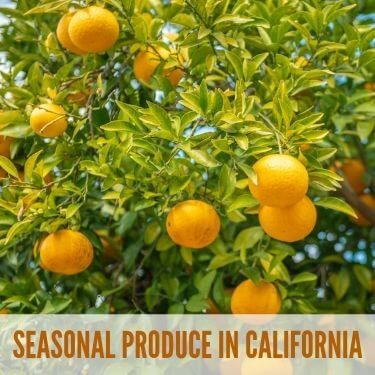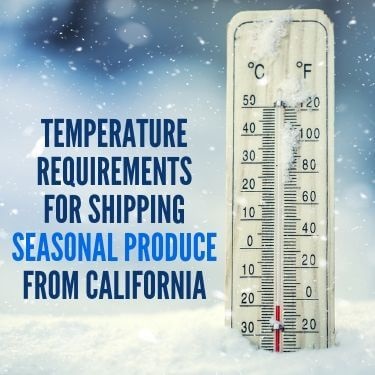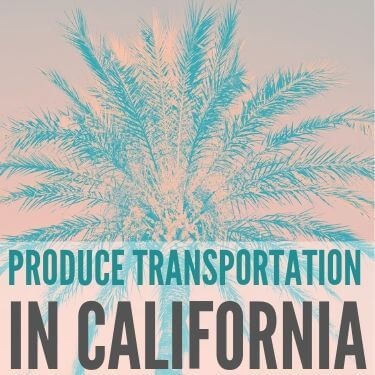While most states in the U.S. are known for growing one unique fruit or vegetable, Florida oranges or Idaho potatoes, California is the nation’s powerhouse of produce. Its unique environment ensures that seasonal produce in California is readily available. The state not only produces most of the nation’s fresh produce but is also the top exporter of produce in the country.
Shipping seasonal produce in California is fast-paced and risky. From start to finish the produce must be moved quickly and safely. There are many considerations and challenges that go into shipping produce, from proper refrigeration to knowing when and what crops are being harvested. Regulations including FDA, DOT and more must be followed as well.
Whether you’re new to shipping produce from California or you’re an experienced veteran, the information below will help you learn more about the ins and outs of this sometimes complicated process.
California is the nation’s leading producer of fruits and vegetables. In fact, four-fifths of the nation’s total produce comes from California. The moderate climate of the state lends itself to plant cultivation year-round. With nearly 77,000 farms operating in the state, it’s no wonder California is the nation’s biggest supplier.
Of course, it’s important to know what plants are available and when. This list breaks down the seasonal produce in California and what produce is available each season:

As you can see, California has no short supply of produce. It continues to be the trendsetter for the rest of the nation as the country’s largest agricultural producer and exporter. But with both seasonal produce and year-round produce, farmers need to know the best methods for getting their goods to market.
Wondering how is lettuce shipped? Learn more about shipping this delicate green.
There are many things to consider when shipping fresh produce, and choosing the right shipping company can make or break your profit. Shipping fresh fruits and vegetables is fast-paced and time-sensitive. The most important part of shipping produce is getting it to the consumer at its freshest point and getting it there safely.
Produce is considered sensitive freight due to the variety of fruits and vegetables that need to be shipped and their individual shelf lives. There is no room for error in the shipping process due to the fact that produce is a consumable item and safety of the customer must come first. Additionally, customers are less likely to buy fresh produce if it doesn’t look fresh. The best way to maintain a healthy appearance and top freshness of produce is to plan and ship it ahead of time under the correct guidelines. This also ensures that the shipment isn’t stopped due to safety violations.
Moreover, because of food safety violations in the past, the FDA is working harder to regulate the transportation of fresh food and produce. The goal of their work is to prevent practices during transportation that create food safety risks. Some of these practices were a failure to refrigerate the food adequately, failure to properly clean vehicles in between shipments, and failure to sufficiently protect food.

The FDA passed the Food Safety Modernization Act (FSMA) in 2011 and its full implementation began in 2017. In response to food safety risks and outbreaks of illness from unsanitary transportation practices, this act ensures food is transported in a safe way.
Key requirements of the act that transportation companies must comply with are the following:
Before you make any agreements with a transportation company you may want to confirm that they comply with all the FDA requirements. This will save you time and money in the long run. As a shipper, you should also maintain constant communication with the transport company to maintain safety and freshness.
Mushrooms are a delicate fungus that requires care when shipping. Learn about shipping mushrooms.
When shipping seasonal produce in California one thing to consider is the cold chain logistics process. As stated earlier, the most important aspect of shipping produce is safety. One way in which this is achieved is through cold chain logistics.
Cold chain logistics refers to how transportation companies keep food products from losing shelf life by keeping constant and consistent temperature levels. If certain temperature levels are not maintained than the product is deemed unusable. This loses money for everyone involved, from transporter to farmer.
There are two ways to keep food products cold: freezing and refrigeration. The low temperatures keep the food from altering its state, thus there are different types of temperatures required for different foods.
Furthermore, old chain logistics is called a chain because there are several steps in the process. A successful cold chain keeps the products in the regulated temperature throughout the entire process, from start to finish. The links in the cold chain logistics process include:
The quality standards for cold chain logistics are regulated by the FDA and include fast shipping, temperature guidelines, and compliance with regulations.
One of the most important ways cold chain logistics is ensured is through the use of refrigerated trucks. Refrigerated transportation is sometimes referred to as reefer freight. These vehicles have a built-in refrigeration system that keeps produce cold. The drivers of reefer freight are trained on how to best manage the truck and how to monitor the temperature gauge.
Again, the FDA monitors all shipping of perishable food so as to decrease foodborne illnesses. Truck drivers of refrigerated trucks must understand all requirements of temperature management and reporting for each shipment. For a long term shipping partnership, finding a company that fully complies with all the FDA regulations is imperative.
As mentioned previously, the cold chain logistics process requires certain temperature controls to maintain the freshness of produce. But what are those temperatures and does it change depending on what produce is being shipping? Absolutely. Fruits and vegetables are fragile freight and organic material and have specific and different needs because of that.
Remember that the goal is to deliver the freshest produce possible, that means the temperature must be consistent and the shipment delivered on time. Any slight variation in the delivery time or temperature could cause the produce to be unusable upon arrival, especially for sensitive produce.

Depending on the item, the recommended temperature during delivery can range anywhere from between freezing at 32 degrees to 60 degrees. To determine what the range should be, look at the bill of lading for each shipment. Truck drivers are able to change temperatures while driving, and should always be monitoring the temperature gauge. They should also always know what produce they are delivering and the specific needs of that freight.
For example, when shipping fruit like apples, blueberries, grapes, peaches, and cantaloupes, or vegetables like broccoli and packaged salad greens, the suggested temperature should be between 32 and 36 degrees.
The temperature can be a little higher for items like avocados and cranberries, between 38 and 40 degrees. Produce such as potatoes, honeydews, and green beans can ship at a temperature range of 40 and 45 degrees. Meanwhile, cucumbers, watermelon, and eggplant are produce that can ship at 45 to 50 degrees.
The highest recommended temperature for shipment of produce is between 55 and 60 degrees. This level of refrigeration is suggested for early crops of potatoes or bananas, grapefruit, and tomatoes.
Ultimately, determining the best temperature for a shipment should be decided on between the shipper and the transportation company. Good communication is an important part of the process. Always keep in mind the shelf life of the product and the goal of delivering on time and fresh.
Shipping fresh produce is always a race against the clock. There are many challenges that impact the shipping of produce. It is especially difficult in California where nearly 223 million tons of freight were shipped internally in Southern California alone. As the state with the nation’s second-largest metropolitan area, California has to deal with many issues in freight transportation that can affect shipping produce. For example, congestion, safety, security, and land use are just some of the challenges to the freight industry in California.
Specifically, when shipping seasonal produce these issues can impact the delivery time and efficiency of the shipments. The challenges of shipping produce start with the seasonality of it. Some fruits and vegetables have growing seasons of just six to eight weeks. But, for grocery stores, the need remains to have fresh tomatoes in stock even in the middle of winter in say, for example, North Dakota. That means those tomatoes are likely traveling very far before reaching their final destination.
Getting produce from its point of origin to the final destination is only one of the challenges of shipping produce. Successful transportation of fresh produce requires a lot of flexibility on the part of the transportation company. Produce shipments coming from California can vary from 1,000 loads per day to 7,000 loads per day, all at different times. This means the transportation company must be able to quickly respond to the demands and needs of the shipper for the transportation of produce to be successful.
Ultimately, the perishable shelf life of produce remains the number one challenge to shipping seasonal produce. If the crop is harvested early or late that will create difficulties in scheduling transportation. If the truck is stopped or delayed by weather that will create difficulties in delivering on time. The trucks refrigeration system must be monitored correctly or else that will also create difficulties in maintaining the freshness of the produce. When shipping seasonal produce, it’s all about the longevity of fruits and vegetables.
The demand for fresh produce is rising as the trend for a healthy lifestyle also rises. Specialty stores, farmers markets, health food stores, and regular grocery markets are seeing an increase in the amount of fresh produce that consumers are buying. The rising demand means that consumers are looking to buy the freshest produce for their new lifestyle. It also means fresh produce must be delivered on a regular basis to these destinations.
Shippers must work very closely with these stores in order to schedule correct delivery times for each market’s specific needs. For example, a large grocery store chain might need fresh produce delivered several times within one week whereas a local health food store will only need one shipment once a week. The shipper will work with the grocery store and the transportation company to meet those needs.
Wholesale produce shippers will also need to work closely with transportation companies to ship their goods to restaurants. The restaurant industry is a huge consumer of fresh fruits and vegetables. Shipping fresh produce to restaurants require the same regulations and standards as shipping anywhere else. If the produce doesn’t arrive fresh and in good condition it’s considered unusable, this is especially important when shipping seasonal produce.
Many restaurants and diners are familiar with the term “seasonally available.” Due to the new trend for healthy lifestyles, Chefs and restaurant owners will work to find ways to create networks of locally sourced produce. This is beneficial when shipping seasonal produce in California, especially because the state has such a vast supply of produce throughout all seasons.
Speaking of shipping produce in California, there is a huge demand for transportation services. The consumption of California’s crops by its population is actually above the national average, not to mention the amount that the state exports. Due to their speed and reliability, trucks dominate the industry in regards to shipping fresh fruits and vegetables. Truck availability is an important aspect for shippers to look into when shipping perishable goods.
There are 400 different commodities grown within the state according to the California Department of Food and Agriculture. The majority of fruits and vegetables in the state are transported by truck. California accounts for three-tenths of the total recorded truck shipments of produce throughout the nation.

Additionally, most produce shipments in California will travel to large distribution centers for repackaging or storage. They’ll then be transported to other markets for their delivery to their final destination. Additionally, most produce that originated in California and is exported to other countries will actually never leave the state itself until final exportation. The state contains such huge ports, such as Los Angeles and San Francisco, that it is unnecessary to transport perishable goods outside of the state for export.
There are three things shippers should know about when shipping seasonal produce in California. The first one is that the availability of transportation services will vastly affect the efficient shipment of produce. It will impact everything from keeping the produce fresh to the profit you’ll earn. Make sure to look for a transportation company that ensures availability. The second thing shippers should know when shipping produce in California is that timeliness of delivery is key. Again, look for transportation companies that have a track record of timely deliveries. Finally, shippers should know to look for a transportation company that is dependable and has high standards of cleanliness.
If you are in a position where you’re looking for transportation for seasonal produce, R+L Global Logistics will supply all your shipping needs. We have a variety of shipping options and understand the process and regulations that are involved in shipping fresh fruits and vegetables. We have mastered cold chain logistics and have a large supply of refrigerated trucks available for your use. We also offer wine transportation services from California, shipping electronics and can ship cars from California.
The R+L Global Logistics team knows the challenges that go into shipping perishable good such as plants and avocados, and we are ready to meet them. Our staff is experienced and has the flexibility to keep up in this fast-paced industry. Whatever type of produce you need shipped, our goal is to ship it quickly and with freshness in mind.
Contact us today to receive a freight shipping in California quote or to learn more about how we can support your freight shipping in California and seasonal produce shipping needs.
R+L Global Logistics
315 NE 14th St., Ocala, FL 34470